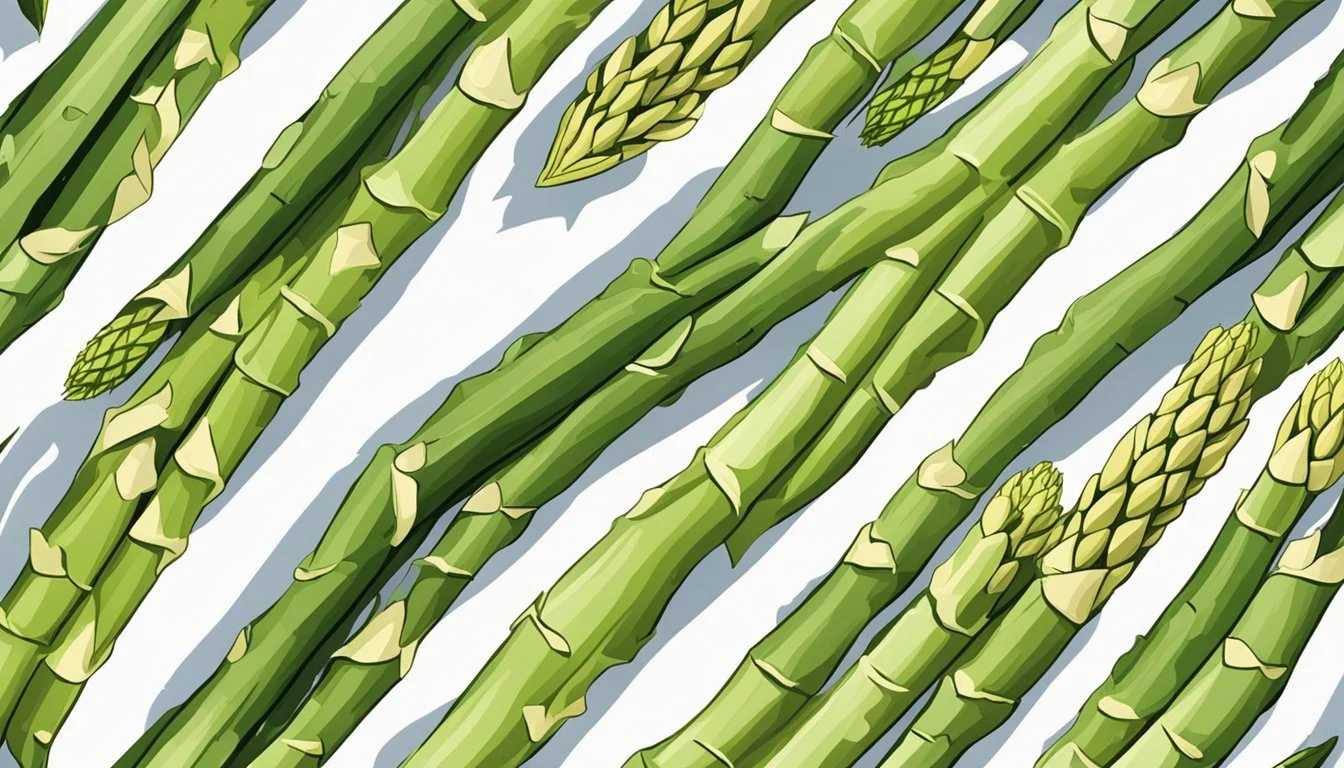How Long Does Asparagus Last?
Your Guide to Storing This Versatile Veggie
Asparagus (how long does asparagus last?), a perennial favorite for its distinct flavor and nutritional benefits, is often a highlight in dishes during its peak season in spring. However, its shelf life can be disappointingly brief if it's not stored properly. Fresh asparagus generally lasts three to five days in the refrigerator. The key to prolonging the freshness of asparagus lies in how it is kept before use. Ensuring that asparagus stays fresh not only retains the quality but also reduces food waste.
To extend the lifespan of fresh asparagus, it is advisable to treat it similarly to flowers. Placing the stalks upright in a container with an inch or two of water can help maintain their crispness for up to a week. This method allows asparagus to absorb moisture, much like a bouquet, and delays wilting. To further preserve their condition, loosely covering the asparagus with a plastic bag while it stands in water is recommended. It is important to check the water regularly and change it if it becomes cloudy to prevent bacteria growth, which can hasten spoilage.
For those who have an abundance of asparagus or wish to store it for longer periods, freezing is a viable option. Cooked asparagus, although more convenient for immediate use, doesn't have as long a shelf life as its fresh counterpart and should be consumed within a couple of days. However, when frozen, both fresh and cooked asparagus can last up to six months. Freezing it properly involves blanching the spears before freezing to preserve flavor and texture, allowing a taste of spring to be enjoyed year-round.
Selecting and Buying Asparagus
When purchasing asparagus, individuals should focus on the freshness and seasonal availability to ensure they obtain the best quality produce. Consumers are encouraged to assess the vibrancy and structural firmness of asparagus stalks at the point of sale.
Identifying Fresh Asparagus at the Market
Consumers looking for fresh asparagus should inspect the vegetable for certain key qualities:
Stalks: They should be plump and firm to the touch.
Tips: Opt for tightly closed and compact tips, as they hold the best flavor.
Skin: Seek out asparagus with smooth, unblemished skin; avoid wrinkled surfaces.
Color: The color should be a rich, vibrant green, though some varieties may be purple or white.
Odor: Fresh asparagus should not have any strong or off-putting smells.
Inspecting asparagus for these characteristics at the market can significantly impact the shelf life and quality of the produce once purchased.
Seasonal Availability of Asparagus
Asparagus is a seasonal vegetable with its peak availability during the spring months. Its quality and abundance may diminish outside of this season:
Spring: The prime time for asparagus, marked by its utmost freshness and flavor.
Winter and Other Seasons: While asparagus can be found year-round in grocery stores, off-season produce might not be as fresh and is often imported.
Consumers should be mindful that asparagus's peak seasonality affects its presence and quality in the market. They may find that springtime asparagus is more vibrant and fresh compared to the year-round offerings at grocery stores.
Storing Asparagus Properly
Proper storage techniques can significantly extend the longevity of asparagus, keeping it fresh and crisp. By following specific practices for refrigeration and exploring alternative storage solutions, individuals can maintain the quality of asparagus for an optimal period.
Optimal Refrigeration Techniques
To store asparagus in the refrigerator, one should initially trim approximately an inch off the ends. The asparagus spears must be kept upright; thus, standing them in a glass or jar filled with an inch or two of water is an effective method. It is critical to retain the rubber band, which holds the bunch together, to maintain organization. The container should then be placed in the fridge, ideally in the crisper drawer to maintain a consistent environment. For enhanced preservation, one may also loosely drape a plastic bag over the standing asparagus, allowing for some air circulation.
Trim ends: Trim an inch off the asparagus ends.
Place upright: Stand asparagus in a container with 1-2 inches of water.
Keep organized: Retain the rubber band on the bunch.
Crisper drawer: Store in the refrigerator's crisper drawer.
Loosely cover: Drape a plastic bag over it, ensuring the bag is not sealed.
Alternative Storage Solutions
When refrigeration is not immediately feasible or one wishes to prepare asparagus for more extended storage, alternative solutions are recommended. Wrapped in a damp paper towel, asparagus can be placed inside an airtight plastic bag to preserve its moisture without becoming waterlogged. As for freezing, blanched asparagus should first be patted dry and then placed in airtight, freezer-safe bags with excess air removed. Labeling containers with the storage date prevents forgetting and assists in effective inventory management.
Moist paper towel: Wrap in a dampened paper towel for moisture retention.
Airtight bag: Store in an airtight plastic bag in the refrigerator.
For freezing: Blanch, dry, and place in airtight, labeled containers for the freezer.
Extending Asparagus's Shelf Life
Extending the shelf life of asparagus is crucial to savoring its fresh flavor and crisp texture. By following specific storage and preservation methods, asparagus can be kept fresh longer, remain palatable when cooked, and even be stored for future use.
Best Practices for Fresh Asparagus
Fresh asparagus should be stored promptly to maintain optimal freshness. The best way to store fresh asparagus is to:
Trim the ends of the stalks.
Stand the stalks upright in a bowl or jar with an inch or two of water.
Cover the asparagus with a plastic bag.
Refrigerate: Store it in the refrigerator and ensure that it remains cool.
Refreshing the water when it becomes cloudy can prolong the asparagus's freshness, typically up to a week. This method helps prevent the asparagus from becoming limp or dry out.
Tips for Leftover Cooked Asparagus
To store leftover cooked asparagus:
Cooling: Allow the asparagus to cool to avoid excess moisture buildup.
Wrapping: Wrap the asparagus in aluminum foil or store it in an airtight container.
Refrigeration: Once wrapped securely, place the asparagus in the refrigerator.
Leftover cooked asparagus should be consumed within a couple of days to maintain its quality and prevent the onset of mold.
Freezing Techniques for Asparagus
For long-term storage, freezing asparagus is an effective technique:
Wash and trim the asparagus stalks.
Blanch the stalks in boiling water for a few moments, then quickly transfer to an ice bath to halt cooking.
Pat the asparagus dry to remove excess moisture.
Arrange in a single layer on a baking sheet to freeze individually.
Once frozen, transfer the asparagus to freezer bags.
When placed in the freezer, asparagus can last for several months. Freezing helps prevent the spears from becoming limp and preserves the vegetable for future use.
Preparing Asparagus for Consumption
Proper preparation of asparagus enhances its flavor and ensures that it can be safely consumed. Attention given to cleaning and trimming paves the way for a variety of cooking methods that best suit one's asparagus recipes.
Proper Cleaning and Trimming
Before cooking, asparagus requires thorough cleaning to remove any dirt or sand. It is advisable to:
Rinse the stalks under cool, running water.
Pat them dry with a clean towel.
Trimming is equally crucial, as the bottom part of asparagus is often tough and woody. One should:
Bend the asparagus stalk gently until it snaps; it will naturally break where the tender part starts.
Alternatively, use a knife to cut about an inch from the bottom.
Cooking Methods for Asparagus
Asparagus can be cooked using various techniques to bring out its natural flavors, catering to a wide range of favorite asparagus recipes. Key methods include:
Boiling: Submerge the stalks in a pot of salted, boiling water for 2-4 minutes, depending on thickness.
Blanching: Cook in boiling water, then immerse in ice water. This preserves the vibrant green color and crisp texture.
For those looking to highlight the vegetable's taste:
Roasting: Place on a baking sheet in a pre-heated oven at 425°F (218°C) for 12-15 minutes.
Grilling: Cook over medium heat for 5-10 minutes, turning occasionally to char evenly.
Each method offers a different texture and flavor suited to a variety of asparagus recipes, allowing the cook to tailor the dish to personal preference or specific culinary requirements.
Understanding Asparagus Deterioration
Asparagus freshness diminishes over time through visible and tactile changes in texture and color. Recognizing these signs can help determine the vegetable's quality.
Signs of Spoilage in Asparagus
The following are indications that asparagus is no longer fresh and may be spoiled:
Texture: Fresh asparagus has a firm texture. Spoilage is often indicated by a soft or mushy feel, especially at the tips, which deteriorate first.
Color: A bright green hue characterizes good asparagus. Look for signs of spoiling, such as color fading to a dull green or yellow and the presence of black spots or brown discolorations.
Mold: If visible, this is a clear sign that asparagus should not be consumed.
Factors Affecting Asparagus Freshness
Several factors contribute to how long asparagus can maintain its freshness:
Storage Method: Asparagus lasts longer when stored properly in the refrigerator, with the stems moistened and upright in water or wrapped in a damp cloth.
Age at Purchase: The longevity of asparagus also depends on its age when bought; fresher stalks will naturally last longer.
Refrigerator Conditions: Variations in humidity and temperature within the refrigerator can accelerate the deterioration process.
Physical Damage: Any cuts or breaks can hasten spoilage as they provide entry points for bacteria.
Understanding these aspects can aid in maintaining the quality of asparagus before it becomes unpalatable.
Health Benefits and Nutritional Information
Asparagus is a nutritious vegetable acknowledged for its low-calorie profile and high concentration of essential nutrients, making it an integral part of a healthy diet.
Asparagus in a Healthy Diet
Asparagus can be a valuable addition to a variety of dishes including soups, quiches, (What wine goes well with quiche?) and salads. It's a versatile vegetable that is not only healthy but can enhance the flavor of any meal. For example, asparagus soup is a light yet nourishing option that takes advantage of asparagus's health benefits while providing a comforting taste experience.
Nutrients Found in Asparagus
Asparagus is packed with vitamins, minerals, and antioxidants. A mere one-half cup (90g) of cooked asparagus typically contains the following:
Calories: 20
Protein: 2.2g
Fat: 0.2g
Carbohydrates: 3.7g
Fiber: 1-2.8g, depending on cooking method and serving size
It also offers:
Vitamin K: Essential for bone health and blood clotting
Vitamin A: Important for immune function, vision, and skin health
Folate: Crucial for cell growth, making it particularly beneficial during pregnancy
Antioxidants: Including vitamins E and C, which help combat oxidative stress and may contribute to reduced inflammation and chronic disease risk
Incorporating asparagus into one's diet can thus contribute to overall health and nutritional balance.
Creative Use of Asparagus in Recipes
Asparagus, with its distinct flavor and versatile texture, is a brilliant ingredient in a variety of dishes, from hearty main courses to light appetizers and sides.
Incorporating Asparagus into Main Courses
One can elevate the nutritional value and taste of their main dishes by adding asparagus. A Creamy Chicken and Asparagus Pasta is a perfect example, where one can cook the asparagus in the same water as the pasta, simplifying the cooking process. Asparagus harmonizes well with chicken, offering a lovely contrast in flavors and textures.
For vegetarians, a Crustless Spinach & Asparagus Quiche with Gruyère is a delightful choice. The combination of fresh asparagus and spinach, held together with rich, melted Gruyère, results in a dish that's both satisfying and full of flavor.
Asparagus-Based Appetizers and Sides
Asparagus can also star in appetizers (What wine goes well with appetizers?) and sides, bringing a splash of color and a rush of nutrients to the table. Roasted asparagus is a crowd-pleaser, requiring just a simple preparation of olive oil, salt, and pepper, and a quick roast in the oven at 400°F for about 12-20 minutes until tender.
For creative appetizers, one can present a Broccoli-Crust Veggie Pizza, where asparagus serves as one of the vibrant toppings. The thin broccoli crust supports a generous array of vegetables, creating a colorful and delicious experience.
Tips for Keeping Asparagus Fresh Longer
To maintain the freshness and nutritional value, including folate, of asparagus, proper storage is critical. The following tips offer specific guidance to prolong the shelf life of this versatile vegetable.
DIY Solutions for Asparagus Care
Storing in Water:
Place asparagus upright in a glass jar with about 1-2 inches of water, similar to how one would store fresh flowers.
Regularly change the water to prevent bacterial growth and spoilage.
Wrapping Technique:
Dampen a tea towel or paper towel, ensuring it's moist but not soaked.
Wrap this towel around the bottom end of the stalks to absorb moisture.
Alternatively, wrap the asparagus in plastic wrap, but make sure it's not airtight as the asparagus still needs to breathe.
Refrigeration:
Always refrigerate asparagus. Place the jar or wrapped asparagus in the crisper section to maintain a consistent temperature.
Common Mistakes to Avoid
Avoiding Dryness:
Do not leave asparagus uncovered in the fridge, as the cold air will dry it out, leading to wilted and less flavorful spears.
Preventing Mold:
Keep asparagus away from excess moisture once in the fridge, as too much can encourage mold. The stalks should be moist but not wet.
Correct Container Use:
Don't use an airtight container if wrapping in a towel. The lack of air circulation can accelerate deterioration.
Timely Consumption:
Utilize asparagus within a reasonable time. Even with proper storage, it's best consumed within a few days for optimal taste and nutritional benefits.
FAQs About Asparagus Care and Usage
Proper storage and preparation techniques are crucial for extending the shelf life of asparagus and preserving its quality. This section addresses common questions about storing asparagus and tips on cooking and preparing it.
Questions About Storing Asparagus
How does one optimally store asparagus in the refrigerator?
In the fridge: To keep asparagus fresh, they should store it standing upright in a jar or glass with an inch or two of water, similar to a bouquet of flowers. It is advisable to loosely cover it with a plastic bag and change the water if it becomes cloudy. This method can keep asparagus hydrated and crisp for up to a week.
Freezing: For longer-term storage, asparagus can be frozen. It should first be portioned into jars or airtight containers before placing it in the freezer, where it can last for up to six months.
Queries on Cooking and Preparing Asparagus
What are the best practices for cooking and preparing asparagus?
Preparation: Before cooking, asparagus should be rinsed thoroughly and the woody ends removed using a sharp knife. The spears can either be snapped off where they naturally break or can be cut about one to two inches from the bottom.
Cooking: Cooking asparagus can be done in various ways, including grilling, roasting, steaming, or boiling. For best results, they should cook asparagus until it is tender but still maintains a slight crispness. It typically takes three to five minutes to boil or steam asparagus, while grilling or roasting can take longer depending on the thickness of the spears.
Conclusion
Asparagus can be kept fresh and usable through proper storage techniques. Fresh asparagus typically lasts 3 to 5 days in the refrigerator. To extend its lifespan to up to 7 days, one should wrap it in a damp cloth or store it standing upright in a jar of water, loosely covered with a plastic bag.
For longer-term storage, asparagus may be frozen, with a shelf life of up to 6 months. Before freezing, blanching the spears is advised. They should be air-dried post-blanching and stored in freezer bags or airtight containers.
Here are concise tips to ensure one's asparagus stays fresh and ready for cooking into healthy recipes:
Refrigerate promptly, ideally in a moisture-retaining setup.
Freeze with care, making sure to blanch and portion the spears beforehand.
Use airtight containers if asparagus is peeled and to be used shortly.
For optimal freshness, purchase asparagus when planning to use it, and cook within a few days.
By following these methods, individuals can enjoy this nutritious vegetable in its best state, infusing a healthy element into their meals.







